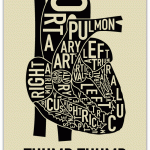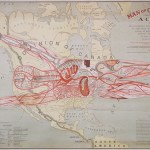This is such a beautiful award-winning image of the complex vascular networks in a pigeon. The image was captured using CT scan technology and a novel contrasting agent called BriteVu that allows visualization of even tiny capillaries. This image was captured by Scott Echols who is a member of the Grey Parrot Anatomy Project, whose goals are to create technologies to study animal anatomy. The complex capillary network located in the neck of this pigeon is important in helping the animal regulate body temperature. Dilation of these blood vessels allows the birds to…
anatomy
Front view of a star-nosed mole. Credit: Ken Catania
Dr. Kenneth Catania from Vanderbilt University presented his work with star-nosed moles at the Experimental Biology meeting last month in Chicago. These animals are really cool. Here are some facts from Dr. Catania about these crazy-looking creatures you may not know:
If participating in a bug-eating contest, they would win hands down every time because they are the fastest-eating mammal known. In fact, they can identify and consume a bug in a record less than two tenths of a millisecond. This is possible…
The newly reported Saadanius hijazensis may or may not be a "missing link" but in order for this monkey to climb onto the primate family tree, a new branch had to be sprouted. So, not only is Saadanius hijazensis a new species, but it is a member of a new taxonomic Family, Saadaniidae, which in turn is a member of a new Superfamily, Saadanioidea. Why is this important? It's complicated. But not too complicated.
The fossil was found while University of Michigan paleontologist Iyad Zalmout was busy looking for dinosaur fossils in western Saudi Arabia. He found the monkey, from a much…
One of those really cool and useful "evolution stories" gets verified and illuminated by actual research. And blogging!
An oystercatcher is a wading bird of the family Haematopodidae, distributed in one genus, Haematopus. As is the case with many coast loving birds, there has been confusion about the limits of the 11 or so species known to exist worldwide. That itself is an interesting story (Hocke 1996), but one we will not go into now.
Adult coastal oystercatchers (some species are not coastal) eat all sorts of animals found in the intertidal zone, including shellfish of all sorts,…
The Free-Ride offspring are currently summering (for a couple weeks, anyway) with The Grandparents Who Lurk But Seldom Comment. Practically, this means the conversations between Free-Ride offspring and parents over the past week have been brief and focused on how awesome day camp is.
I have, however, taken steps to ensure that while I am deprived of the physical presence of my offspring, you will not be deprived of the weekly installment of sprog blogging. To this end, I gave each of the sprogs a book to read during their visit with their grandparents and asked them to report back on their…
The "common cuttle-fish." From Mysteries of the Ocean.
About three decades before On the Origin of Species by Means of Natural Selection would forever change biological science, the aspiring young naturalists Pierre-Stanislas Meyranx and Laurencet submitted a paper on mollusks to France's prestigious Academie des Sciences. For weeks they waited for a patron from within the scientific elite to recognize their work, but no response came. Ultimately they decided to take the more direct route of having the paper examined by a commission, and in 1830 the naturalists Pierre-Andre Latreille and…
The Free-Ride offspring have been wary of extended conversations with me lately (maybe since most of them eventually come around to, "Surely you'd like to help your mother grade these papers!"). However, I was able to extract some pictorial evidence that each of them has been thinking about science.
From the younger Free-Ride offspring, some basic things you ought to know about phases of matter:
Also worthy of note: vocabulary from the most recent science unit was included with this week's spelling words. (Hurray for viscosity!)
Sure, we haven't yet integrated the discussion about…
tags: Eyjafjallajökull, volcanic particulate material, ash clouds, airborne-particle deposition, respiratory physiology, respiratory toxicology, medicine, veterinary medicine, birds, avian health, bioassay, anatomy, researchblogging.org,peer-reviewed research, journal club
Figure 1: The eruption of Eyjafjallajökull, photographed by a farmer in Iceland. This eruption sent massive billowing clouds of volcanic ash several miles into the atmosphere.
Image: Ãlafur Eggertsson (Newscom/Zuma) [larger view]
April is the peak month of spring migration for millions of birds, so the ongoing…
tags: evolutionary biology, evolutionary biogeography, molecular biology, medicine, ectoparasite, orificial hirudiniasis, mucosal leech infestation, hirudinoids, leech, Tyrannobdella rex, public health, zoology, PLoS ONE, anatomy, phylogenetic analysis, taxonomy, researchblogging.org,peer-reviewed research, journal club
Figure 1. Mucosally invasive hirudinoid leeches. Known from a wide variety of anatomical sites including eyes (A) as in this case involving Dinobdella ferox (B), mucosal leech species, as in a case involving Myxobdella annandalei (C), more frequently feed from the…
The preserved head of a California sea lion (Zalophus californianus), dissected and dyed to show some of the glands inside the head. From the collections of the New Jersey State Museum (originally from the College of New Jersey).
A restoration of the giant, durophagous shark Ptychodus, courtesy paleo-artist Matt Celeskey.
The study of prehistoric sharks is no easy task. Specialists in other branches of vertebrate paleontology at least have the reasonable hope of discovering complete skeletons of their subjects; except in instances of exceptional preservation the scientists who study sharks typically only have teeth and a few vertebrae to work with. Still, you can tell a lot about a shark by its teeth, and a new study published in Cretaceous Research suggests that one peculiar form was a shell-crushing giant.…
A grizzly bear (the black dot in the middle of the photo) walking near the treeline in Yellowstone's Hayden Valley.
The quiet of my evening wildlife watching was suddenly broken by a thick Boston accent. "Oh my gawd! Look! It's a grizz! That's the last animal I needed to see! It's a grizz!"
He was right. Lumbering across the valley was a big dark shape that could only be a bear. It was not very close, being little more than a dot moving along the distant treeline, but through the zoom lens of my camera it was just possible to make out the hump that distinguishes black bears from grizzly…
Early this month, my better half got something for the Free-Ride offspring that is somewhere in the realm of "this will be edifying, but maybe they'll find it cool, and if they don't then at least the grown-ups will have fun playing with it".
So far, it has been all of the above.
It's a human anatomy model (not life-size, thanks), and here's the state I found it in this morning:
Obviously, this isn't going to stifle my children's creativity.
The sprogs appreciate that you can "break it down," as it were, to see how brain rests in skull and how neck connects to torso.
They also like how you…
tags: physiology, The Bloodmobile, They might be Giants, music video, streaming video
Here's another fun music video; "The Bloodmobile" by the creative group, They Might be Giants. This song tells about the many functions of blood, from providing oxygen to tissues to helping transport hormones (well, hormones are generally transported in the plasma).
Father Heart, 2006
Black Nickel on Rolled Steel; Glass Tank - 80cc with pedal
Josh Hadar
It's always puzzled me that bicycles don't take better advantage of the gleaming potential of curvacious, polished metal. Why are most bike frames so boring and triangular? Fortunately Josh Hadar has come to the rescue, with his beautiful curved steel custom bicycles. They're all lovely, but when he adds blown glass "hearts" to their steel ribs, his bikes seem positively. . . alien. Isn't it interesting that adding elements of human anatomy makes the bikes seem more unnatural? More bikes (and the…
The Aquatic Ape Theory is being discussed over at Pharyngula. As PZ points out, an excellent resource on this idea is Moore's site on the topic. Here, I just want to make a few remarks about it.
The Aquatic Ape Theory (AAT) is a human evolution Theory of Everything (TOE) and thus explains, as it should, everything. That is a dangerous way for a theory to act, because if it tries to explain everything then it is going to be wrong in a number of places, and it is going to seem (or even be) right in a number of places but only by chance. (Unless, of course, the TOE is totally rad and really…
Ornament(al) Skull
Noah Scalin
Anatomophiles alert: tomorrow, Noah Scalin, proprietor of the Skull-A-Day blog and author of Skulls, opens a new show at the Quirk Gallery in Richmond, VA.
I just typed "Richmoaned". Does that qualify as a Freudian slip? Or something else?
Joanna of Morbid Anatomy is on a quest to locate private collections of medical oddities. She's already sussed out fourteen such hidden wunderkammern and photographed their treasures, but she wants to find more:
"Who are these private collectors, and what sort of treasures do they possess? How might their methods of displaying collections differ from institutional approaches? Are we reaching a historical moment similar to the pre-museum era of private cabinets, in which the most interesting artifacts are now in private rather than public hands?"
It's a really interesting question.…
As a fan of maps, typography, and anatomy, I think this is a pretty sweet mashup.
From orkposters.com via Street Anatomy.
Another fabulously weird map, from the great blog Strange Maps. This one is entitled "The Man of Commerce" and dates to 1889.
According to the American Geographical Society Library,
The highly detailed 31" x 50" map/chart conflates human anatomy with the American transportation system, in an apparent attempt to promote Superior as a transportation hub.Its metaphor makes West Superior "the center of cardiac or heart circulation"; the railways become major arteries; and New York is "the umbilicus through which this man of commerce was developed."The explanatory notes conclude: "It is an…



